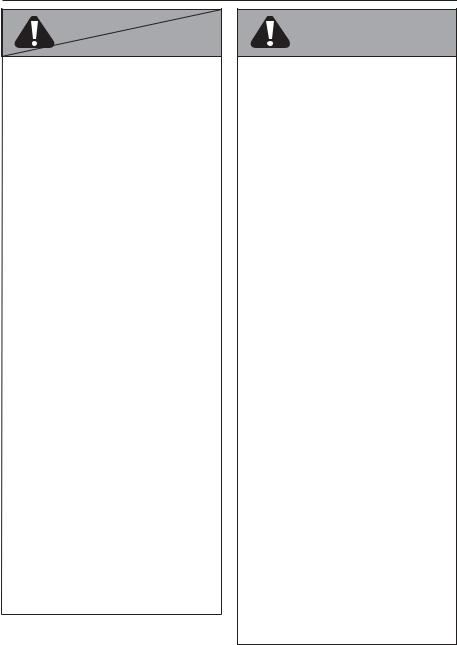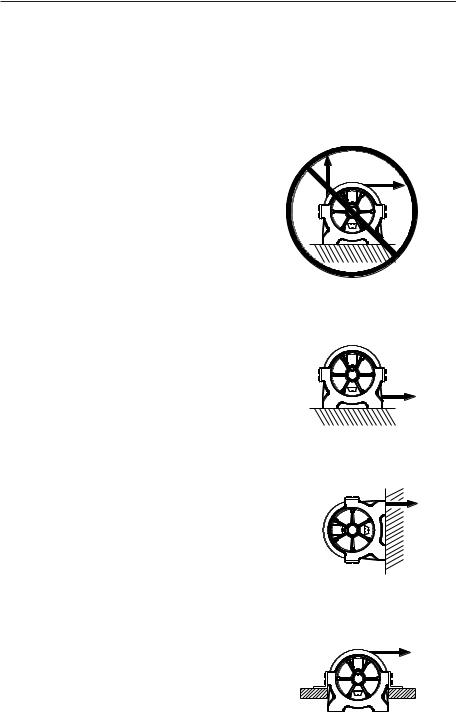WARN 30XL User Manual

General Safety Precautions
Warnings and Cautions
As you read these instructions, you will see WARNINGS, CAUTIONS, NOTICES and NOTES. Each message has a specific purpose. WARNINGS are safety messages that indicate a potentially hazardous situation, which, if not avoided could result in serious injury. CAUTIONS are safety messages that indicate a potentially hazardous situation which, if not avoided, could result in minor or moderate injury. A CAUTION may also be used to alert against unsafe practice. CAUTIONS and WARNINGS identify the hazard, indicate how to avoid the hazard, and advise of the probable consequence of not avoiding the hazard. NOTICES are messages to avoid property damage. NOTES are additional information to help you complete a procedure. PLEASE WORK SAFELY!
WARNING
MOVING PARTS ENTANGLEMENT HAZARD
Failure to observe these instructions could lead to severe injury or death.
To avoid injury to hands or fingers:
•Always keep hands clear of rope, hook loop, hook and fairlead opening during installation, operation and when spooling in or out.
•Always use extreme caution when handling hook and rope during spooling operations.
WARNING
CHEMICAL AND FIRE HAZARD
Failure to observe these instructions could lead to severe injury or death.
•Always remove jewelry and wear eye protection.
•Never lean over battery while making connections.
•Always verify area is clear of fuel lines, fuel tank, brake lines, electrical wires, etc. when drilling.
•Never route electrical cables:
-Across any sharp edges.
-Through or near moving parts.
-Near parts that become hot.
•Always insulate and protect all exposed wiring and electrical terminals.
•Always install terminal boots as directed in installation instructions.
WARNING
Failure to observe these instructions could lead to property damage, severe injury, or death
•Never exceed the maximum recommended hydraulic pressure or flow for any of the components used.
•Always connect the winch to the hydraulic system as shown in the hydraulic schematic.
•Always use the correct type of control valve as shown in the hydraulic schematic.
•Always Stand clear of hydraulic lines during operation.
•Always install hydraulic components in accordance with manufacturer’s recommendations.
1

General Safety Precautions
CAUTION
MOVING PARTS ENTANGLEMENT HAZARD
Failure to observe these instructions could lead to minor or moderate injury.
General Safety:
•Always know your winch. Take time to fully read the Installation and Operations Guide in order to understand your winch and its operation.
•Never operate this winch if you are under 16 years of age.
•Never operate this winch when under the influence of drugs, alcohol or medication.
•Never exceed winch or rope capacity listed on product data sheet. Double line using a snatch block to reduce winch load.
Installation Safety:
•Always choose a mounting location that is sufficiently strong to withstand the maximum pulling capacity of your winch.
•Always use factory approved mounting hardware, components, and accessories.
•Always use grade 8 or better mounting hardware.
•Never weld mounting bolts.
•Always use care when using longer bolts than those supplied from factory. Bolts that are too long can damage the base and/or prevent the winch from being mounted securely.
•Always position fairlead with WARNING label on top.
•Always prestretch wire rope and respool under load before use. Tightly wound wire rope reduces chances of “binding”, which can damage the rope.
CAUTION
MOVING PARTS ENTANGLEMENT HAZARD
Failure to observe these instructions could lead to minor or moderate injury.
•Always inspect, rope, hook, and slings before operating winch. Damaged components must be replaced before operation. Protect parts from damage.
•Never hook rope back onto itself. This damages the rope.
•Always use a choker chain, choker rope, or tree trunk protector on the anchor.
•Always remove any element or obstacle that may interfere with safe operation of the winch.
•Always take time to use appropriate rigging techniques for a winch pull.
•Always be certain the anchor you select will withstand the load and the strap or chain will not slip.
•Never engage or disengage clutch if winch is under load, rope is in tension or drum is moving.
•Always double line or pick distant anchor point when rigging. This maximizes pulling power and avoids overloading the winch.
•Never winch with less than 5 wraps of rope around the drum. The rope could come loose from the drum.
•Never touch rope or hook while in tension or under load.
•Never touch rope or hook while someone else is at the control switch or during winching operation.
•Always stand clear of rope and load and keep others away while winching.
•Always be aware of stability of vehicle and load during winching. Alert all bystanders of any unstable condition.
2

General Safety Precautions
CAUTION
CUT AND BURN HAZARD
Failure to observe these instructions could lead to minor or moderate injury.
To avoid injury to hands and fingers:
•Always wear heavy leather gloves when handling a wire rope.
•Never let rope slip through your hands.
•Always be aware of possible hot surface at winch motor, drum or rope during or after winch use.
CAUTION
MOVING PARTS ENTANGLEMENT HAZARD
Failure to observe these instructions could lead to minor to moderate injury.
•Always use a hook with a latch
•Always insure hook latch is closed and not supporting load.
•Never apply load to hook tip or latch. Apply load only to the center of hook.
•Never use a hook whose throat opening has increased, or whose tip is bent or twisted.
WARNING
FALLING OR CRUSHING HAZARD
Failure to observe these instructions could lead to severe injury or death.
•Never use winch to lift or move persons.
•Never use winch as a hoist or to suspend a load.
NOTICE
AVOID WINCH AND EQUIPMENT DAMAGE
•Always avoid side pulls which can pile up rope at one end of the drum. This can damage rope or winch.
•Always ensure the clutch is fully engaged or disengaged.
•Never use winch to tow other vehicles. Shock loads can momentarily exceed capacity of rope and winch.
•Always use care to not damage the vehicle frame when anchoring to a vehicle during a winching operation.
•Never “jog” rope under load. Shock loads can momentarily exceed capacity of rope and winch.
•Never use winch to secure a load during transport.
•Never submerge winch in water.
•Always store the remote control in a protected, clean, dry area.
3

WARN Industrial Winches
What is a Winch?
WARN Industries produces a large family of winches and hoists. But what makes a winch different than a hoist?
Winches and hoists look alike. Both consist of a motor, a rotating drum with rope, reduction gears, a base, and usually an electrical control system.
However, winches and hoists are used for different purposes.
Winches are used to pull a load horizontally across the ground, while hoists are used to lift a load into the air. Unlike hoists, the operator of a winch may unwind cable by “free spooling” or disengaging the motor from the gear train using the built-in clutch. Then the operator reverses the position of the clutch to connect the motor to the gears and pull the load.
Pre-Install Checklist
1Check to see that you have received the following:
•The winch
•The winch mounting hardware
2Upon removing winch from packaging, check for damage including bent or cracked tie rods, tie bars, or housings. Correct any damage before installing winch.
3Make sure the environment surrounding winch and controller is free of :
•Combustible vapors
•Chemical fumes
•Oil vapors
•Corrosive material
4Make sure that the air temperature surrounding the winch and controller stays within 120° F (49° C) and -20° F (-29° C).
5Make sure that the mounting structure can withstand the full rated pull of the winch.
Mounting the Winch
Mounting Bolts:
Use the supplied fasteners whenever possible or SAE Grade 8 bolts of the same thread size. The tie plates, tensioner bracket, and spacers supplied with the winch should NOT be removed. Mounting brackets (if required) should be added to the tie plates and spacers supplied with the winch. Mounting brackets thicker than ½ inch (12mm) in thickness may require longer mounting bolts to be used. The bolt threads must extend a minimum of ¾ inch (19mm) into the drum supports. Bolts that are too long or too short will fail to anchor the winch securely and may cause a failure of the winch mounting.
Mounting Brackets:
When foot mounting the winch, the mounting plate should be a minimum of ½ inch thick steel. A thinner mounting plate will not support the winch properly and may cause a failure of the winch mounting. Foot mounting plates thicker than 1/2 inch (12mm) will require longer mounting bolts.
When side mounting the winch, brackets must be a minimum of 4 inch (100mm) by 4 inch (100mm) by ½ inch (12mm) thick angle iron or larger.
Mounting brackets with inadequate thickness may cause a failure of the winch mounting. Side mounting brackets thicker than 1/2 inch (12mm) will require longer mounting bolts.
1Make sure that the mounting surface is flat within +/-0.020 in. (0.50 mm). If the surface is not flat, use shim stock as needed to avoid straining the winch.
2Torque all mounting bolts to the recommended values on the product data sheet.
3Use the mounting hole locations provided on the product data sheet.
4

WARN Industrial Winches
Mounting Configurations
This section illustrates the recommended mounting configurations for the Series XL winch. This section does not include every possible mounting configuration, but illustrates the correct methods for mounting the winch.
Foot Down Mounting Position:
DO NOT wind the rope from the top of the drum. DO NOT position the load direction away from the mounting surface.
Foot Down Mounting Position:
DO wind the rope from the bottom of the drum.
Foot Forward Mounting Position:
DO wind the rope from the top or bottom of the drum towards the direction of the mounting surface.
Side Mount:
DO wind the rope from the top of the drum.
5
